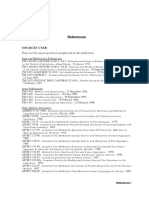PostgreSQL Subquery
Uploaded by
Alberto GiudiciPostgreSQL Subquery
Uploaded by
Alberto GiudiciPostgreSQL Subquery
1 di 5
http://www.postgresqltutorial.com/postgresql-subquery/
PostgreSQL Subquery
Summary: in this tutorial, you will learn how to use the PostgreSQL subquery that allows you to
construct complex queries.
Introduction to PostgreSQL subquery
Lets start with a simple example.
Suppose we want to nd the lms whose rental rate is higher than the average rental rate. We can
do it in two steps:
Find the average rental rate by using the SELECT statement and average function ( AVG ).
Use the result of the rst query in the second SELECT statement to nd the lms that we
want.
The following query gets the average rental rate:
1 SELECT
2
AVG (rental_rate)
3 FROM
4
film
The average rental rate is 2.98
Now, we can get lms whose rental rate is higher than the average rental rate:
1 SELECT
13/12/2016 16.05
PostgreSQL Subquery
2 di 5
http://www.postgresqltutorial.com/postgresql-subquery/
1 SELECT
2
film_id,
title,
rental_rate
5 FROM
6
film
7 WHERE
8
rental_rate > 2.98
The code is not so elegant, which requires two steps. We want a way to pass the result of the rst
query to the second query in one query. The solution is to use a subquery.
A subquery is a query nested inside another query such as SELECT, INSERT, DELETE and
UPDATE . In this tutorial, we are focusing on the SELECT statement only.
To construct a subquery, we put the second query in brackets and use it in the WHERE clause as an
expression:
1
SELECT
film_id,
title,
rental_rate
FROM
film
WHERE
rental_rate > (
SELECT
10
AVG (rental_rate)
11
FROM
12
film
13
The query inside the brackets is called a subquery or an inner query. The query that contains the
subquery is known as an outer query.
13/12/2016 16.05
PostgreSQL Subquery
3 di 5
http://www.postgresqltutorial.com/postgresql-subquery/
subquery is known as an outer query.
PostgreSQL executes the query that contains a subquery in the following sequence:
First, executes the subquery.
Second, gets the result and passes it to the outer query.
Third, executes the outer query.
PostgreSQL subquery with IN operator
A subquery can return zero or more rows. To use this subquery, you use the IN operator in the
WHERE clause.
For example, to get lms that have the returned date between 2005-05-29 and 2005-05-30 ,
you use the following query:
1 SELECT
2
inventory.film_id
3 FROM
4
rental
5 INNER JOIN inventory ON inventory.inventory_id = rental.inventory_id
6 WHERE
7
return_date BETWEEN '2005-05-29'
8 AND '2005-05-30'
It returns multiple rows so we can use this query as a subquery in the WHERE clause of a query as
follows:
1
SELECT
film_id,
title
4
5
FROM
film
13/12/2016 16.05
PostgreSQL Subquery
4 di 5
film
WHERE
film_id IN (
SELECT
inventory.film_id
http://www.postgresqltutorial.com/postgresql-subquery/
10
FROM
11
rental
12
INNER JOIN inventory ON inventory.inventory_id = rental.inventory_id
13
WHERE
14
return_date BETWEEN '2005-05-29'
15
AND '2005-05-30'
16
PostgreSQL subquery with EXISTS operator
The following expression illustrates how to use a subquery with EXISTS operator:
1 EXISTS subquery
A subquery can be an input of the EXISTS operator. If the subquery returns any row, the
EXISTS operator returns true. If the subquery returns no row, the result of EXISTS operator is
false.
The EXISTS operator only cares about the number of rows returned from the subquery, not the
content of the rows, therefore, the common coding convention of EXISTS operator is as follows:
1 EXISTS (SELECT 1 FROM tbl WHERE condition)
See the following query:
1
SELECT
first_name,
last_name
FROM
13/12/2016 16.05
PostgreSQL Subquery
5 di 5
4
5
6
http://www.postgresqltutorial.com/postgresql-subquery/
FROM
customer
WHERE
EXISTS (
SELECT
10
FROM
11
payment
12
WHERE
13
payment.customer_id = customer.customer_id
14
The query works like an inner join on the customer id column. However, it returns at most one row
for each row in the customer table even though there are some corresponding rows in the
payment table.
In this tutorial, you have learned how to use the PostgreSQL subquery to construct complex
queries.
13/12/2016 16.05
You might also like
- 5-PostgreSQL WHERE - Filtering Rows of A QueryNo ratings yet5-PostgreSQL WHERE - Filtering Rows of A Query6 pages
- Using Advanced SQL: Department of Information Systems School of Information and TechnologyNo ratings yetUsing Advanced SQL: Department of Information Systems School of Information and Technology30 pages
- Select Modifying Data: SQL Cheat Sheet - PostgresqlNo ratings yetSelect Modifying Data: SQL Cheat Sheet - Postgresql3 pages
- Subqueries With The SELECT Statement: ExampleNo ratings yetSubqueries With The SELECT Statement: Example4 pages
- PG - Stat - Monitor A Feature-Rich and Enhanced Version of PG - Stat - StatementsNo ratings yetPG - Stat - Monitor A Feature-Rich and Enhanced Version of PG - Stat - Statements39 pages
- Udemy Course Notes: Complete SQL BootcampNo ratings yetUdemy Course Notes: Complete SQL Bootcamp29 pages
- Udemy Course Notes: Complete SQL BootcampNo ratings yetUdemy Course Notes: Complete SQL Bootcamp29 pages
- Subqueries With The SELECT Statement:: Ramesh Ahmedabad Khilan Delhi Kota Chaitali MumbaiNo ratings yetSubqueries With The SELECT Statement:: Ramesh Ahmedabad Khilan Delhi Kota Chaitali Mumbai29 pages
- MySQL JOINS Are Used With SELECT StatementNo ratings yetMySQL JOINS Are Used With SELECT Statement7 pages
- Really Big Elephants: Data Warehousing PostgresqlNo ratings yetReally Big Elephants: Data Warehousing Postgresql62 pages
- SUBQuereis - Corelated Queries - IN - ANY - ALLNo ratings yetSUBQuereis - Corelated Queries - IN - ANY - ALL35 pages
- Unit 9 - Retrieve Data Using SubqueriesNo ratings yetUnit 9 - Retrieve Data Using Subqueries20 pages
- Advanced SAS Interview Questions You'll Most Likely Be AskedFrom EverandAdvanced SAS Interview Questions You'll Most Likely Be AskedNo ratings yet
- Spring Boot Intermediate Microservices: Resilient Microservices with Spring Boot 2 and Spring CloudFrom EverandSpring Boot Intermediate Microservices: Resilient Microservices with Spring Boot 2 and Spring CloudNo ratings yet
- PostgreSQL NATURAL JOIN Explained by ExampleNo ratings yetPostgreSQL NATURAL JOIN Explained by Example4 pages
- Full English-Gb9685-2008, April 12th China Food ContactNo ratings yetFull English-Gb9685-2008, April 12th China Food Contact260 pages
- DuctWatch IR Gas Detector Instruction ManualNo ratings yetDuctWatch IR Gas Detector Instruction Manual32 pages
- Deep Learning in C# - Understanding Neural Network Architecture - CodeProjectNo ratings yetDeep Learning in C# - Understanding Neural Network Architecture - CodeProject4 pages
- Ncert Solutions Class 9 Math Chapter 13 Surface Area and VolumesNo ratings yetNcert Solutions Class 9 Math Chapter 13 Surface Area and Volumes97 pages
- Cutter Option: Installation InstructionsNo ratings yetCutter Option: Installation Instructions14 pages
- [FREE PDF sample] CURRENT Diagnosis Treatment Gastroenterology Hepatology Endoscopy 1st Edition Norton Greenberger ebooksNo ratings yet[FREE PDF sample] CURRENT Diagnosis Treatment Gastroenterology Hepatology Endoscopy 1st Edition Norton Greenberger ebooks67 pages
- Evaluation of Ergosterol Composition and Esterification Rate in Fungi Isolated From Mangrove Soil, Long-Term Storage of Broken Spores, and Two SoilsNo ratings yetEvaluation of Ergosterol Composition and Esterification Rate in Fungi Isolated From Mangrove Soil, Long-Term Storage of Broken Spores, and Two Soils15 pages
- ST5227 Applied Data Mining: Sun Baoluo, Chan Hock Peng100% (1)ST5227 Applied Data Mining: Sun Baoluo, Chan Hock Peng24 pages
- Earth Resistivity Measurement Interpretation TechniquesNo ratings yetEarth Resistivity Measurement Interpretation Techniques9 pages
- Using Advanced SQL: Department of Information Systems School of Information and TechnologyUsing Advanced SQL: Department of Information Systems School of Information and Technology
- Select Modifying Data: SQL Cheat Sheet - PostgresqlSelect Modifying Data: SQL Cheat Sheet - Postgresql
- PG - Stat - Monitor A Feature-Rich and Enhanced Version of PG - Stat - StatementsPG - Stat - Monitor A Feature-Rich and Enhanced Version of PG - Stat - Statements
- Subqueries With The SELECT Statement:: Ramesh Ahmedabad Khilan Delhi Kota Chaitali MumbaiSubqueries With The SELECT Statement:: Ramesh Ahmedabad Khilan Delhi Kota Chaitali Mumbai
- Advanced SAS Interview Questions You'll Most Likely Be AskedFrom EverandAdvanced SAS Interview Questions You'll Most Likely Be Asked
- Spring Boot Intermediate Microservices: Resilient Microservices with Spring Boot 2 and Spring CloudFrom EverandSpring Boot Intermediate Microservices: Resilient Microservices with Spring Boot 2 and Spring Cloud
- Full English-Gb9685-2008, April 12th China Food ContactFull English-Gb9685-2008, April 12th China Food Contact
- Deep Learning in C# - Understanding Neural Network Architecture - CodeProjectDeep Learning in C# - Understanding Neural Network Architecture - CodeProject
- Ncert Solutions Class 9 Math Chapter 13 Surface Area and VolumesNcert Solutions Class 9 Math Chapter 13 Surface Area and Volumes
- [FREE PDF sample] CURRENT Diagnosis Treatment Gastroenterology Hepatology Endoscopy 1st Edition Norton Greenberger ebooks[FREE PDF sample] CURRENT Diagnosis Treatment Gastroenterology Hepatology Endoscopy 1st Edition Norton Greenberger ebooks
- Evaluation of Ergosterol Composition and Esterification Rate in Fungi Isolated From Mangrove Soil, Long-Term Storage of Broken Spores, and Two SoilsEvaluation of Ergosterol Composition and Esterification Rate in Fungi Isolated From Mangrove Soil, Long-Term Storage of Broken Spores, and Two Soils
- ST5227 Applied Data Mining: Sun Baoluo, Chan Hock PengST5227 Applied Data Mining: Sun Baoluo, Chan Hock Peng
- Earth Resistivity Measurement Interpretation TechniquesEarth Resistivity Measurement Interpretation Techniques






























































































